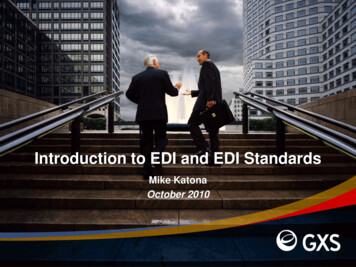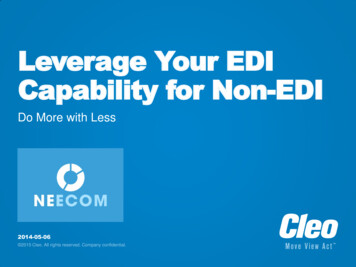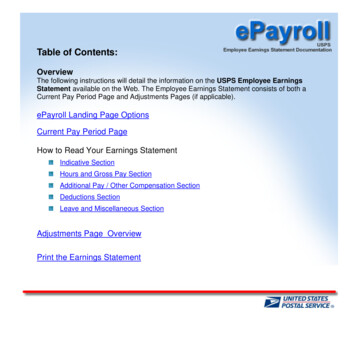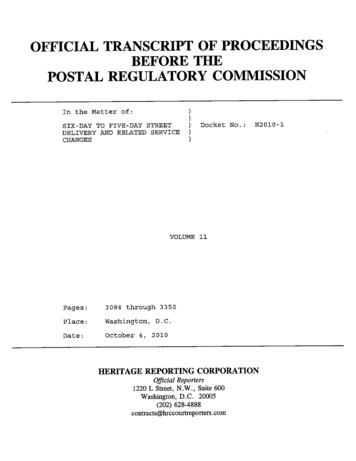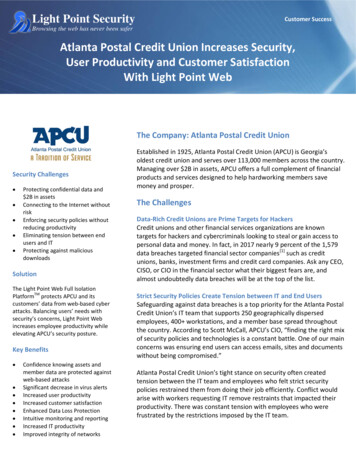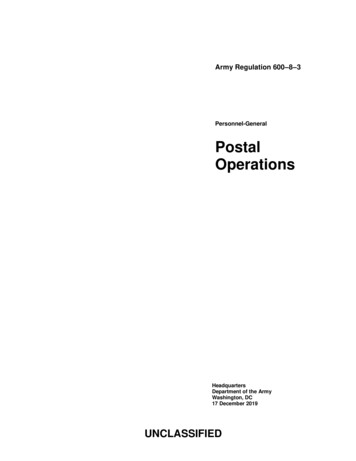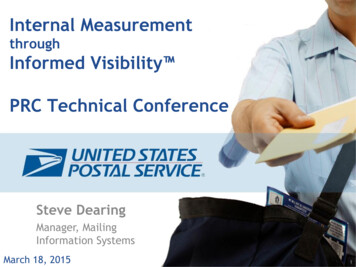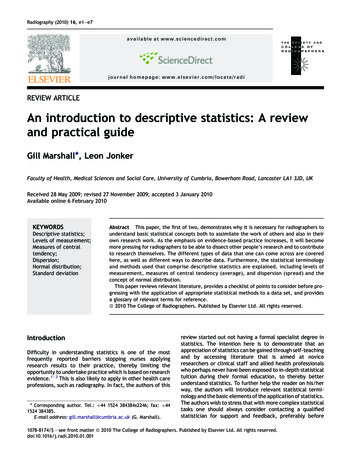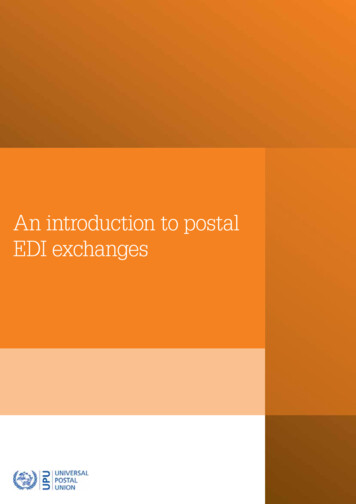
Transcription
An introduction to postalEDI exchanges
Date of approval of this version:9 April 2013An introduction to postal EDIexchangesUPU standards are updated in their entirety. Each update results in a new version, indicated by the version number followingthe number of the standard. Before using this document, please check in the Catalogue of UPU Standards that it is still valid.The Catalogue is freely available on the UPU website at www.upu.int. UPU 2013 – All rights reservedi
DisclaimerThis document contains the latest information available at the time of publication. The Universal Postal Union offersno warrants, express or implied, regarding the accuracy, sufficiency, merchantability or fitness for any purpose ofthe information contained herein. Any use made thereof is entirely at the risk and for the account of the user.Warning – intellectual propertyThe Universal Postal Union draws attention to the possibility that the implementation of this standard might involvethe use of a claimed intellectual property right. Recipients of this document are invited to submit, with theircomments, notification of any relevant rights of which they are aware and to provide supporting documentation.As of the date of approval of this standard, the Universal Postal Union had not received such notice of anyintellectual property which might be required to implement this standard, other than what is indicated in thispublication. Nevertheless, the Universal Postal Union disowns any responsibility concerning the existence ofintellectual property rights of third parties, embodied fully or partly, in this Universal Postal Union standard.Copyright notice UPU, 2013. All rights reserved.This document is copyright-protected by the UPU. While its reproduction for use by participants in the UPUstandards development process is permitted without prior permission from the UPU, neither this document nor anyextract from it may be reproduced, stored or transmitted in any form for any other purpose without prior writtenpermission from the UPU.Requests for permission to reproduce this document for other purposes should be addressed to:Universal Postal UnionStandards ProgrammeP.O. Box 3123000 BERNE 15SWITZERLANDTel: 41 31 350 3111Fax: 41 31 350 3110E-mail: standards@upu.intReproduction for sales purposes may be subject to royalty payments or a licensing agreement.ii UPU 2013 – All rights reserved
ContentsForeword . iv1Introduction . 12What is EDI? . 13What is EDIFACT?. 14What is XML? . 35Format of postal EDI messages: EDIFACT, XML or both? . 46Postal EDI messages: a short history . 47What are EDI messages used for today? . 58Who defines postal EDI standards? . 69How are EDI standards implemented in an IT solution? . 710What is an EDI network? . 711What is an EDI address? . 81212.112.212.312.412.512.612.7How to navigate through a UPU EDI messaging standard document . 9Table of contents . 9Data structure . 10Business data elements . 11Branching diagram . 12EDIFACT segments table . 13EDIFACT message specification . 13Conclusion . 1413How can EDI exchanges be started and monitored? . 1414What are code lists? . 1515Where can more information be found? . 16Bibliography . 17 UPU 2013 – All rights reservediii
ForewordPostal services form part of the daily life of people all over the world. The Universal Postal Union (UPU) is thespecialised agency of the United Nations that regulates the universal postal service. The postal services of its 192member countries form the largest physical distribution network in the world. More than 5 million postalemployees working in over 660 000 post offices all over the world handle an annual total of 434 billion letter-postitems in the domestic service and 5,5 billion in the international service. More than 6 billion parcels are sent bypost annually. Keeping pace with the changing communications market, postal operators are increasingly usingnew communication and information technologies to move beyond what is traditionally regarded as their corepostal business. They are meeting higher customer expectations with an expanded range of products and valueadded services.Standards are important prerequisites for effective postal operations and for interconnecting the global network.The UPU's Standards Board develops and maintains a growing number of standards to improve the exchange ofpostal-related information between postal operators and promotes the compatibility of UPU and internationalpostal initiatives. It works closely with postal handling organisations, customers, suppliers and other partners,including various international organisations. The Standards Board ensures that coherent standards aredeveloped in areas such as electronic data interchange (EDI), mail encoding, postal forms and meters.UPU standards are drafted in accordance with the rules set out in Part V of the "General information on UPUstandards" and are published by the UPU International Bureau in accordance with Part VII of that publication.iv UPU 2013 – All rights reserved
An introduction to postal EDI exchanges1IntroductionThis document provides general information about postal EDI exchanges. It begins with basic details andprogresses into more sophisticated concepts. It also describes common practices in EDI exchanges.This document has been written for newcomers to postal EDI. These include technical providers who may not befamiliar with the postal world, as well as anybody involved in the implementation, monitoring or maintenance ofpostal EDI exchanges.This document assumes some knowledge of postal processes. Readers without any postal backgroundwhatsoever would benefit by first learning the basics of the international mail process and learning the meaning ofterms like mail item, receptacle, despatch, consignment, and so on.2What is EDI?EDI stands for Electronic Data Interchange. It is a generic acronym that covers the electronic exchange of data,usually between different parties.Many industries exchange data through EDI networks. They use standards like EDIFACT (see next section). Forexample, EDI networks routinely link car manufacturers with subcontractors and enable all parties tocommunicate and exchange data efficiently. Each car manufacturer exchanges data with many subcontractorsand each subcontractor may work for several car manufacturers; the EDI network facilitates exchanges byproviding a single communication channel for all parties.Technically, an EDI transmission can be seen as a tagged delimited message set. The purpose of a tag is toinform how to handle the following data.In the postal world, the term ‘EDI exchanges’ is used to refer to the electronic exchange of messages based onUPU EDI messaging standards. Most postal EDI messages exchanged today are based on EDIFACT .3What is EDIFACT?EDIFACT (UN/EDIFACT) stands for (the United Nations rules for) Electronic Data Interchange for Administration,Commerce and Transport. Established as a standard by the United Nations in the late 1970s1, it later became anISO standard (ISO 9735) [3].EDIFACT is a text-based standard for formatting data intended to be exchanged electronically. EDIFACT is thus aformat for EDI exchanges.EDIFACT defines a basic grammar. An EDIFACT message is made up of segments. Each segment is made upof data elements. A data element may in turn have several components.1 UN/EDIFACT contains a set of internationally agreed standards, directories, and guidelines for the electronic interchange ofstructured data, between independent computerized information systems. UPU 2013 – All rights reserved1
A listing of the special characters corresponding to this grammar is given below:Type of characterSpecial charactersExampleSegment tagA predefined 3-letter code as thefirst data element of the segment(the list of allowed codes is also partof the EDIFACT standard)UNBSeparator between segments'FTX AAQ CN::139'FTX INS N::139'Separator between data elements RFF ACU:20'Separator between components ofa data element:GID 1:BG'An example of a complete EDIFACT segment illustrating the various separators is given below:UNB UNOC:3 5012345678901:14 4598765432198:14 000316:1402 INV73529 INVOIC'EDIFACT also defines many message types defining different business aspects. Each message type has amessage name and is defined by rules about what the content of the message may be, how data is organized,how many instances of each data element can be filled, which data elements are mandatory, which data elementsare optional, and so on.A basic principle of EDIFACT is the concept of envelope and messages in a transmission: an EDIFACT transmission is a complete set of data elements packaged and transmitted together. Atransmission comprises one interchange and one set of messages; the envelope, called the interchange, is the outer layer of an EDIFACT transmission. The envelopedefines who the sender is and who the recipient is. Technically, this is covered by a start segment (segmenttag UNB) and an end segment (segment tag UNZ);. the inner layer of an EDIFACT message is a set of messages. Every element of this message setconforms to one of the EDIFACT message types or a message standard based on the EDIFACT messagetypes. Technically, this is covered by a start segment (UNH) and an end segment (UNT).A typical EDIFACT transmission looks like this (indentation has been added to show structure):UNB ’UNH ’ UNT ’UNH ’ UNT ’UNH ’ UNT ’UNZ ’messagemessageinterchangemessageExample of a complete EDIFACT interchange, containing several messages (carriage returns and indentationhave been added to improve readability):UNB UNOA:1 FR103:UP IT102:DL 120301:0900 INTREF886'UNH MESREF1159 RESDES:1:912:UP'BGM ITMXPAFRCYMADCN20106'GID 1'PCI CW:ITMXPAFRCYMADCN20106001001455'FTX AAQ CN::139' FTX INS N::139'2 UPU 2013 – All rights reserved
FTX RET N::139'MEA WT AAB KGM:145.5'RFF ACU:20'DTM 7:1203010838:201'GID 1'PCI CW:ITMXPAFRCYMADCN20106002101775'FTX AAQ CN::139'FTX INS N::139'FTX RET N::139'MEA WT AAB KGM:177.5'RFF ACU:20'DTM 7:1203010837:201'UNT 19 MESREF1159'UNH MESREF1160 RESDES:1:912:UP'BGM ITMXPAFRCYMACCN20067'GID 1'PCI CW:ITMXPAFRCYMACCN20067001101273'FTX AAQ CN::139'FTX INS N::139'FTX RET N::139'MEA WT AAB KGM:127.3'RFF ACU:20'DTM 7:1203010837:201'UNT 11 MESREF1160'UNH MESREF1161 RESDES:1:912:UP'BGM ITMXPAFRSLMAACR20060'GID 1:BG'PCI CW:ITMXPAFRSLMAACR20060001100016'FTX AAQ CR::139'FTX INS N::139'RFF ACU:20'DTM 7:1203010705:201'UNT 9 MESREF1161'UNZ 3 INTREF886'NOTEClearly, persons seeking to design new EDIFACT-based EDI messages must thoroughly understand EDIFACT.However, persons seeking only to understand or implement an existing postal EDI message in an IT solution can get by withmore basic knowledge. For the latter category the EDI message definition explained in the concerned UPU standardsdocument is usually enough.4What is XML?XML [4] stands for Extended Markup Language. It is a structured representation of information, with eachinformation element tagged. Tags are descriptive. PostalAddress, EventTime, Identifier, DespatchDate, are allexamples of data descriptors that serve as tags.XML is a W3C (World Wide Web Consortium) [5] standard and is very widely used in internet-related applications.A key feature of XML is its flexibility.XML schemas define rules concerning the structure and allowed contents of XML documents. UPU 2013 – All rights reserved3
5Format of postal EDI messages: EDIFACT, XML or both?EDIFACT was developed well before XML came into existence. Postal EDI exchanges, which also started wellbefore XML was developed, were initially always in EDIFACT format.Industry has two choices today. Should exchanges be EDIFACT-based or XML-based? Some industries areswitching to XML, while others prefer to stay with EDIFACT. Some have a mixture of both.Each approach has advantages: EDIFACT is compact, robust, and widespread; XML is flexible, easy to implement, and can handle any alphabet or language (the technical feature allowingthis is called Unicode, which is a coding mechanism extensive enough to cover all existing alphabets).Concerning the flexibility on alphabet and languages, it must be noted that although EDIFACT is not as flexible asXML, it still provides a level of flexibility. It must also be noted that the XML flexibility can be restricted if required.In fact, handling any alphabet or language may not always be seen as an advantage in EDI exchanges: it isimportant that the alphabet and language used by the party sending a message are understood by the partyreceiving it.With the same contents, the size of an XML message can be up to five times bigger than the equivalent EDIFACTrepresentation. As communication costs are usually based on message size, this is strongly in favour ofEDIFACT; but solutions are being elaborated for the compression of XML messages.A few recent postal EDI standards are defined in XML, or in both EDIFACT and XML.XML exchanges are only beginning. The postal industry will need to acquire more experience with XML beforedeciding which format is best in the long term.Some parties exchanging EDI messages use IT solutions called ‘EDI translators’. Translators help interfacesystems by seamlessly converting formats between EDIFACT and other system-specific formats and storagearchitectures. An EDI translator is thus a tool that seamlessly converts data between formats. Using such a toolsimplifies the implementation of EDI messaging, especially in the case of EDIFACT. An EDI translator normallyincludes all EDIFACT rules and grammar. When configuring such a tool to handle a postal EDI message basedon EDIFACT, it is important to inform the tool about the EDIFACT message and version on which the postal EDImessage is based. This information is provided in UPU Messaging Standards. For example, document M41 [7],describing the EDI message PREDES version 2.1, indicates that this message is a subset of the EDIFACTIFCSUM D06A standard message (this is mentioned in Chapter 6.1 ‘Branching diagram’ of the M41 document).6Postal EDI messages: a short historyElectronic data exchanges were first developed and used to track individual EMS items. The message used forthis purpose was called EMSEVT [7], standing for EMS EVenTs.Most postal EDI messages based on EDIFACT are derived from a standard EDIFACT message type. However,EDIFACT rules or parent EDIFACT message structure are not strictly followed in some cases. In these cases, thepostal industry found it advantageous to deviate slightly from some rule. EMSEVT, for example, deviates fromEDIFACT rules – it is not based on any classical EDIFACT standard, and uses non-standard segment tags. Thisdeviation was made because doing so yielded some advantages.The first generation of postal EDI messages was developed in EDIFACT format in the 1990s. The main messagesof this generation include: EMSEVT [7][16]: initially defined for EMS, it was subsequently used also for parcels and registered, insuredand express letters; PREDES [7][12]: a message from a despatch sender (origin operator) to pre-advise the destinationoperator about the despatch being sent;4 UPU 2013 – All rights reserved
RESDES [9]: response from the destination operator to a PREDES message; PRECON [6]/RESCON [11]: same purpose as PREDES/RESDES, but at the consignment level; CARDIT/RESDIT [12]: CARDIT is a message sent by a postal operator to a carrier (airline) to pre-advisemail and indicate on what transport (flight) the carrier should put the mail; RESDIT is the reply from thecarrier (airline) indicating what has been done with the mail (several events, covering several steps of theprocess).Some small adjustments to these messages were made over the years, with new versions established as needed.For example, the initial PREDES version was called PREDES V1.1. It was later superseded by PREDES V2.0.This first generation of messages was relatively simple. Each message had a well-defined scope.The second generation of postal EDI messages like EVTRPT [14] and ITMATT [15] was developed in the 2000s.These messages were also in EDIFACT format, at least initially. The initial driver for this second generation wasthe requirement of some postal operators to use license plates as identifiers for mail items.License plates are identifiers guaranteed to be unique. However, unlike other postal identifiers, they do notprovide any information about the item. This characteristic, combined with the relatively long length of licenseplate identifiers, made it necessary to review messages using license plates. The second generation of messagesalso had a different approach to EDI exchanges. Instead of having a limited and pre-defined scope, the newmessages were as open as possible so that they could meet both current and future needs.The use of license plates by postal operators remains limited. The relative complexity of these new messages didnot encourage their widespread adoption. Some second-generation messages were withdrawn for these reasons.Others, however, remain
An introduction to postal EDI exchanges 1 Introduction This document provides general information about postal EDI exchanges. It begins with basic details and progresses into more sophisticated concepts. It
